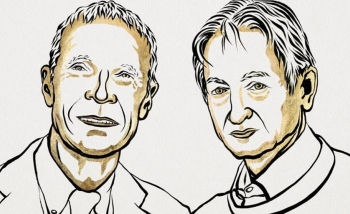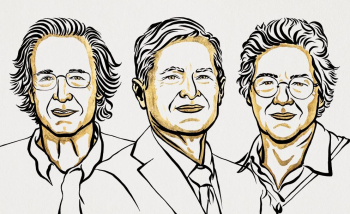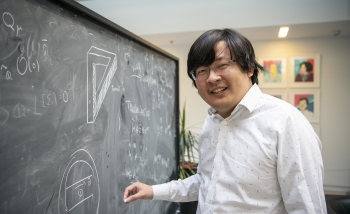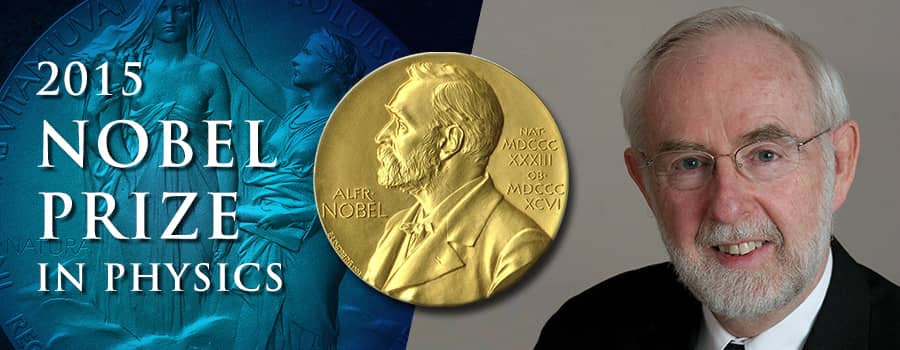After spending much of his career two kilometres underground, Art McDonald was thrust into a bright spotlight this fall when he shared the 2015 Nobel Prize in Physics for his landmark work on neutrino oscillations at the subterranean SNOLAB near Sudbury.
The honour was quickly followed by the Breakthrough Prize in Fundamental Physics, recognizing McDonald’s team and four other neutrino research groups worldwide.
For the humble McDonald, professor emeritus at Queen’s University and a member of Perimeter’s Board of Directors, the awards were an opportunity to highlight the team efforts that make great science possible.
“This is a tremendous honour for me and my Canadian and international collaborators on the SNO experiment,” McDonald said of the recognition. “We are very pleased to have been able to add to our scientific knowledge in a very fundamental way.”
The discovery that neutrinos can flip between their three types – changing from electron neutrinos to muon neutrinos to tau neutrinos and back again – was a truly great piece of science. Like many great scientific breakthroughs, it both resolved a long-standing anomaly and opened doors to new understandings.
Experts on solar fusion had calculated how many neutrinos emitted by the sun should reach Earth, but experimentalists only found about a third of the predicted number. This was the solar neutrino anomaly. Either physicists did not understand the sun, or they did not understand neutrinos.
To nuclear and particle physicists like McDonald, the fact that exactly two-thirds of the neutrinos were missing was suggestive. Neutrinos were known to come in three types, but neutrino detectors could detect only one of them: the electron neutrino (the type emitted by the sun). But what if the sun’s electron neutrinos could shift to muon or tau neutrinos en route? These muon and tau neutrinos would pass by undetected – and two-thirds of the solar neutrinos would appear to be missing.
It was an interesting hypothesis, facing two big challenges. First, the idea that neutrinos can change type requires them to have mass. (Basically, they are allowed to shift because of quantum uncertainty, and the mass is the source of that uncertainty.) But the Standard Model of particle physics required massless neutrinos. At that point, the Standard Model had explained all experimental results and resisted all experimental challenges for more than 20 years. The idea that it might be wrong was radical.
Second, the prospect of measuring all three neutrino types was daunting. Measuring neutrinos at all is difficult, but detecting those that can only interact via fleeting and rare muon and tau physics seemed nearly impossible.
The experiment to find the missing neutrinos would be ambitious and difficult – but it seemed possible. And it happened in Canada, at what would come to be called the Sudbury Neutrino Observatory, or SNO. Art McDonald was a leader in early discussions about SNO and was elected its director in 1991.
Why Canada? Atomic Energy Canada had more than a tonne of heavy water stockpiled, and using heavy water would allow experimentalists to measure all three types of neutrinos. The Creighton Mine in Sudbury, among the deepest in the world, offered a suitable site: putting the experiment two kilometres underground would block most of the roar of background radiation, allowing the tiny whispers of the neutrino signals to be heard.
It took almost 10 years to build the experiment and make it work, but it did work.SNO announced the discovery of neutrino oscillation in 2001. This one discovery – that neutrinos can change their type, and therefore have mass – has changed our understanding of the innermost workings of matter.
As the Nobel committee wrote, “new discoveries about [neutrinos’] deepest secrets are expected to change our current understanding of the history, structure, and future fate of the universe.”
Perimeter hosted a congratulatory reception for McDonald shortly after the Nobel announcement, during which he likened Perimeter's collaborative, ambitious atmosphere to that of SNOLAB.
“From an engineering point of view, what we were trying to do [at SNOLAB] was pretty difficult,” said McDonald. “But from an intellectual point of view, what you’re doing here is massive, and you’re doing it very well.”
– Erin Bow and Colin Hunter
THE SYSTEM WORKED -- THEN, ZAP!
As a graduate student at Princeton in the early 1980s, Robert Myers needed to get his hands dirty. He had aspirations to do theoretical research in quantum gravity, but the university insisted he get hands-on lab experience before beginning his PhD studies. So, at the urging of a friend, Myers nervously knocked on the door of Art McDonald.
Myers and McDonald, it turned out, had already spent years in close proximity to one another: Myers grew up in the northern Ontario town of Deep River, near Chalk River Laboratories, a nuclear research facility where hundreds of scientists – including McDonald for 12 years prior to his Princeton professorship – worked.
Myers needed lab experience. McDonald had brought a polarized electron source to Princeton from Chalk River, and he needed help getting it running in the basement of Princeton’s Jadwin Hall. “He gave me a tour of the lab, described the project, then told me to get to work,” Myers recalls. So Myers got to work, wiring up the power supplies and counters, always keenly aware of the encroaching deadline to qualify for PhD studies.
One day, McDonald popped down to join Myers in the lab and began taking measurements of electron polarization. The system worked beautifully – for a while. Then, zap! An electrical arc shut down the apparatus and blew the lighting fuses, leaving Myers and McDonald standing in the dark. “Well,” an amused McDonald told his protégé in the darkness, “I guess your work here is done.”
McDonald went on to win a Nobel Prize for his work in experimental physics. Myers got into the PhD program but stuck with theoretical physics, eventually becoming a founding faculty member at PI. But Myers has always been grateful to the mentor who allowed him to tinker in the lab. “My first thought when Art won the Nobel: it couldn’t have happened to a nicer guy,” says Myers.
About PI
Perimeter Institute is the world’s largest research hub devoted to theoretical physics. The independent Institute was founded in 1999 to foster breakthroughs in the fundamental understanding of our universe, from the smallest particles to the entire cosmos. Research at Perimeter is motivated by the understanding that fundamental science advances human knowledge and catalyzes innovation, and that today’s theoretical physics is tomorrow’s technology. Located in the Region of Waterloo, the not-for-profit Institute is a unique public-private endeavour, including the Governments of Ontario and Canada, that enables cutting-edge research, trains the next generation of scientific pioneers, and shares the power of physics through award-winning educational outreach and public engagement.
You might be interested in



